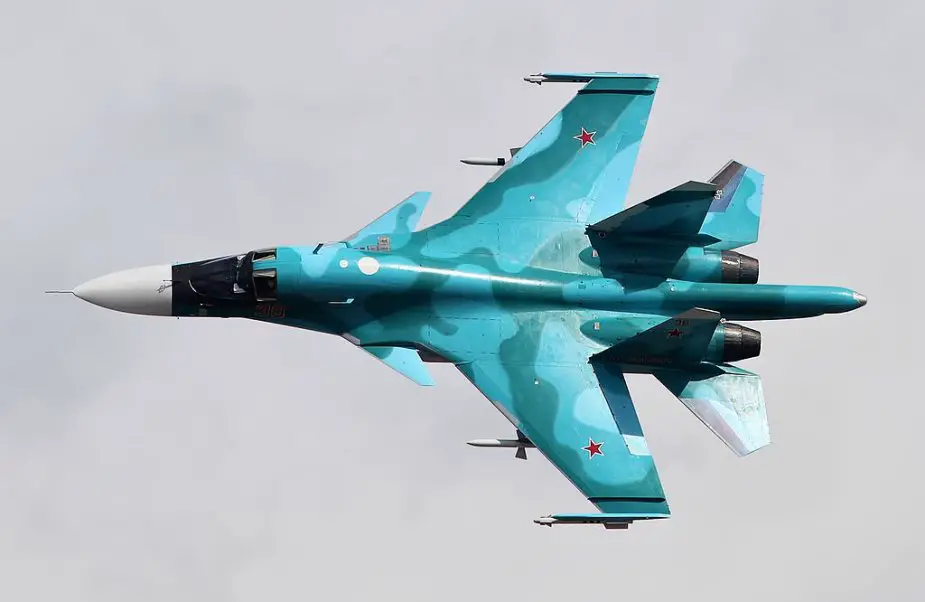The standard training program of Sukhoi Su-34 bomber pilots will be expanded. They will be trained to fight at major altitudes and supersonic speed. The bomber will engage both medium and long-range missiles. It will be able to defend itself at major distances where fighter jets cannot protect it, the Izvestia daily writes.
Follow Air Recognition on Google News at this link
 Sukhoi Su-34 bomber (Picture source: Vitaly Kuzmin)
Sukhoi Su-34 bomber (Picture source: Vitaly Kuzmin)
Sukhoi Su-34 (« Fullback » in NATO denomination system) is a Soviet-origin Russian twin-engine, twin-seat, all-weather supersonic medium-range fighter-bomber/strike aircraft. It first flew in 1990, intended for the Soviet Air Forces, and it entered service in 2014 with the Russian Air Force. Based on the Sukhoi Su-27 Flanker air superiority fighter, the Su-34 has an armored cockpit for side-by-side seating of its two-man crew. The Su-34 is designed primarily for tactical deployment against ground and naval targets (tactical bombing/attack/interdiction roles, including against small and mobile targets) on solo and group missions in daytime and at night, under favourable and adverse weather conditions and in a hostile environment with counter-fire and electronic Warfare (EW) counter-measures deployed, as well as for aerial reconnaissance. The Su-34 will eventually replace the Su-24 tactical strike fighter and the Tu-22M3 long-distance bomber.
So, until now, the Su-34 has been used exclusively as an attack aircraft against ground and sea targets and to provide electronic warfare protection to other bombers. There were few reports on the engagement of close-combat missiles and air-to-air weapons in Syria for self-defense.
Su-34 numerously featured at various shows with fighter jet air-to-air missiles. It carries short-range R-73 and medium-range R-27 missiles. There were reports that the bomber can also engage R-77 missiles against air targets at a distance of 110 km.
The Aerospace Forces operate close to 130 Su-34. The construction of the first batch of upgraded bombers began this year. They have more powerful and various weapons.
A record contract for the delivery of medium-range air-to-air R-77-1 missiles is being fulfilled. It will eliminate the shortage of such missiles which will arm squadrons of Su-57 and Su-35S and other jets. “Su-34 is a frontline bomber with an expanded range which enjoys fighter jet capabilities. There is nothing difficult in it. We have trained fire at air targets since Su-17 appeared,” former Commander of the 4th air force and defense army Lieutenant-General Valery Gorbenko said.
The frontline bombers will not be engaged in air defense, but will be capable of defending themselves, he added. “It is a powerful supersonic aircraft which can engage air-to-air missiles against adversary fighter jets at an altitude of 15 km. Su-34 is maneuverable and can engage in aerobatics and air combat. It is heavier than fighter jets which is to be taken into account in pilot training. It is difficult for a pilot when the bomber carries a full payload,” he said.
Theoretically, bombers have to be accompanied by fighter jets. In reality, there is a lack of fighter jets for protection. Su-34 can operate autonomously and defend itself. It can also attack bombers, if necessary, Gorbenko said.
Su-34 design began in late 1980s on the basis of Su-27 fighter jet. Besides an ordinary set of unguided and guided munitions, it is armed with a gun and can carry six air-to-air short and medium-range missiles.
Su 34 has been engaged in Syria since the start of the Russian operation. It is the main carrier of precision weapons. Fourteen bombers were deployed at Humaymim airbase at a time during the most intensive fighting against terrorists. After the Turkish F-16 downed a Russian Su-24M bomber over Syria on November 24, 2015, Su-34 began to carry air-to-air short and medium-range missiles for self-defense. However, it did not last for long and the bombers were engaged only as attack aircraft, the Izvestia said.
© Copyright 2020 TASS. All rights reserved. This material may not be published, broadcast, rewritten or redistributed.
















